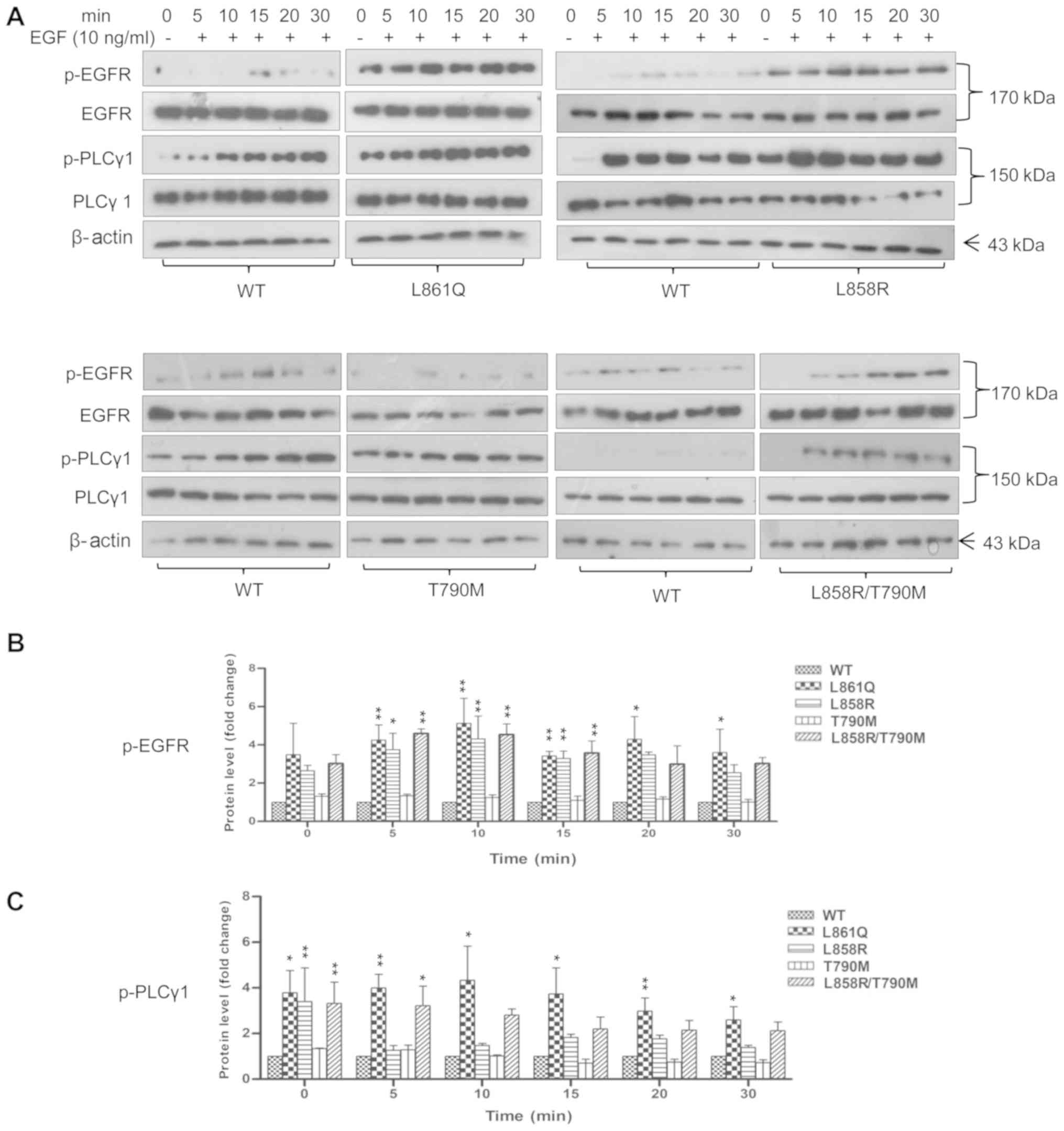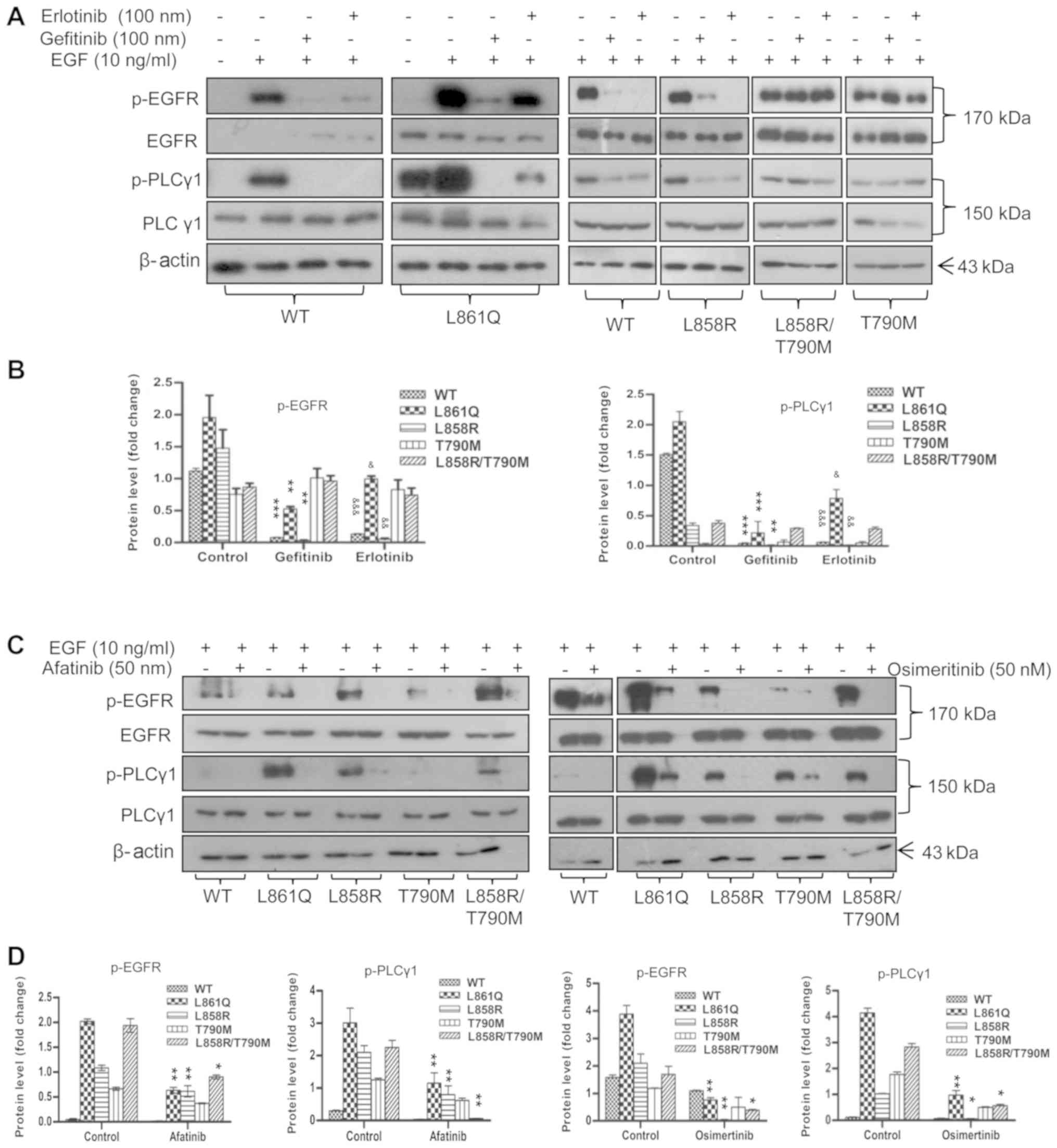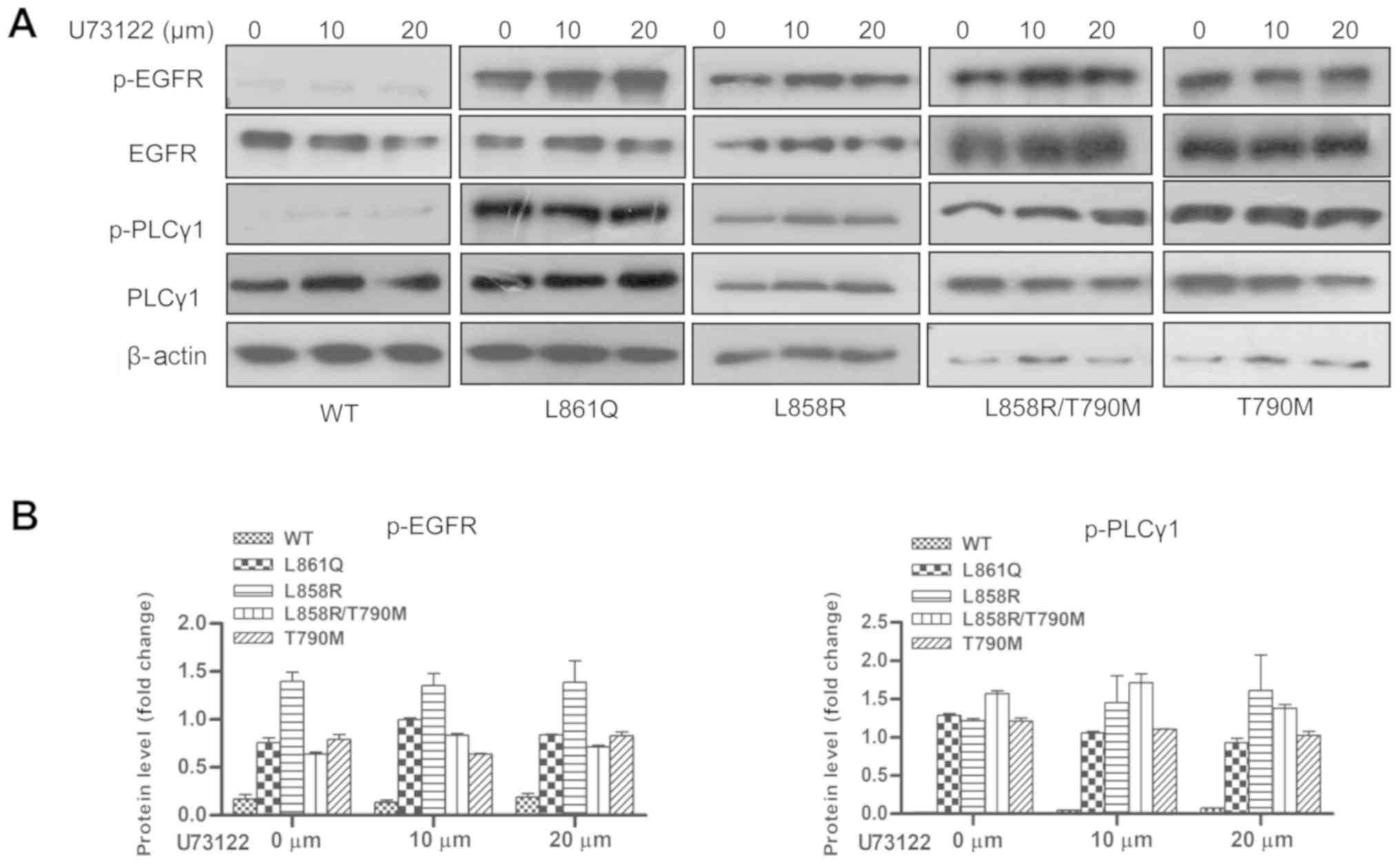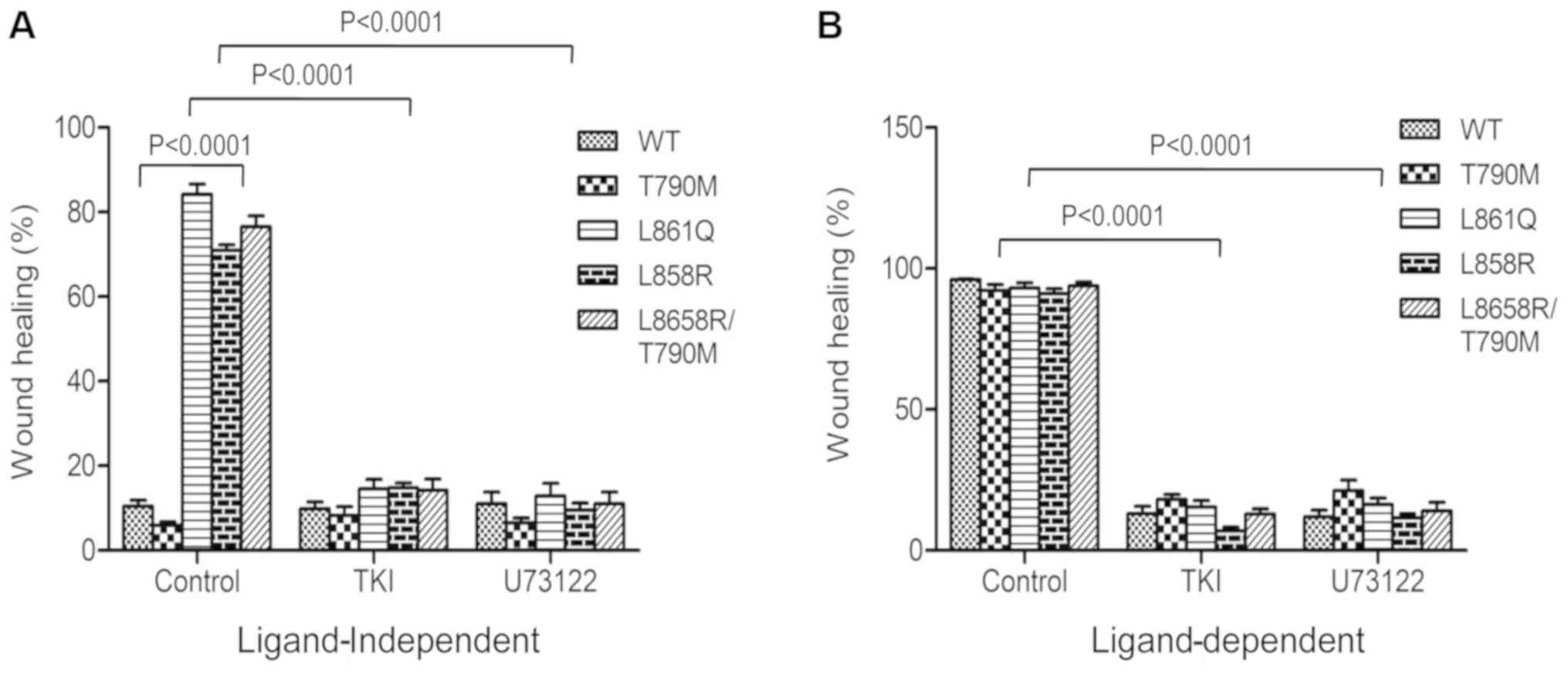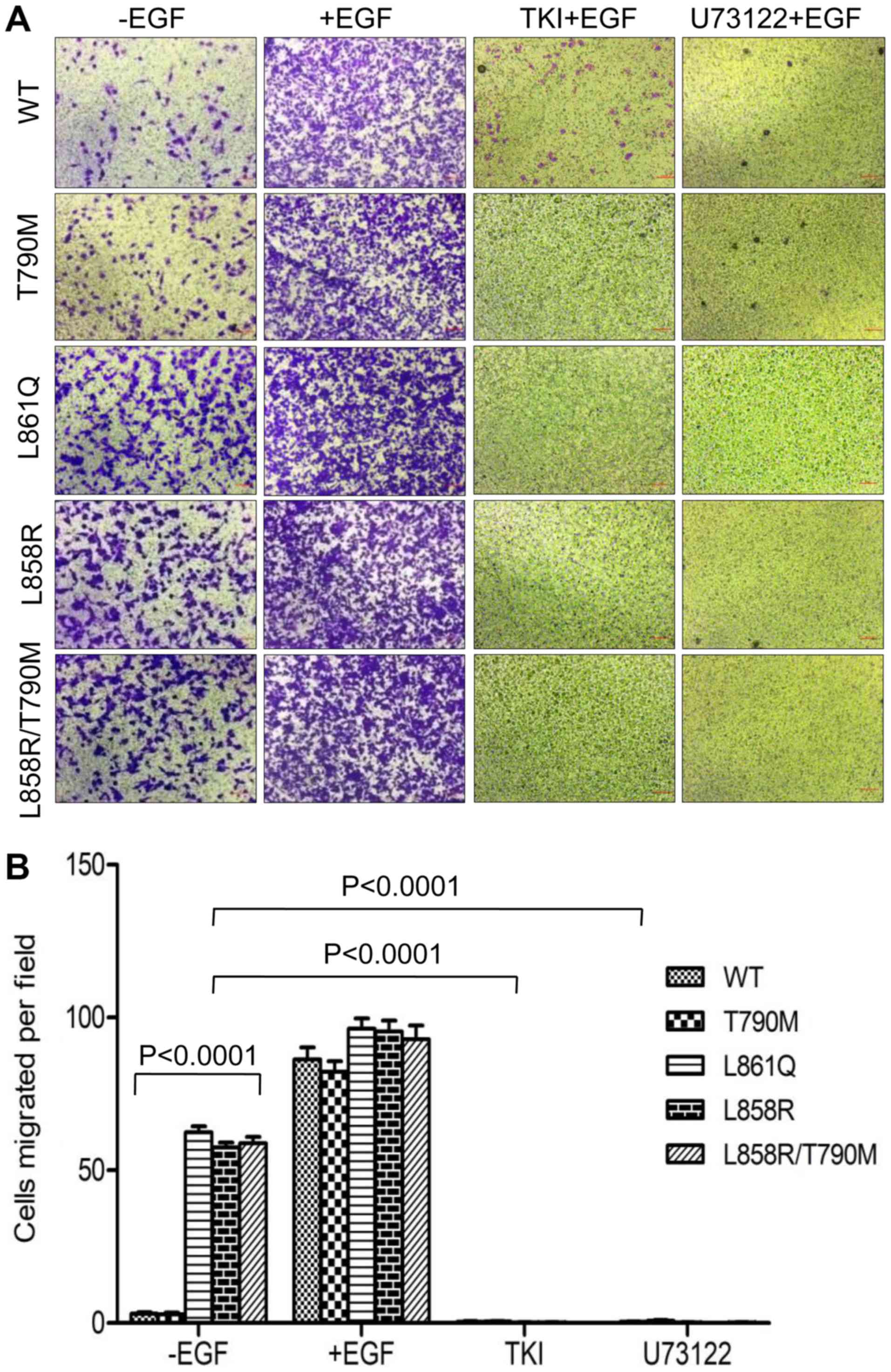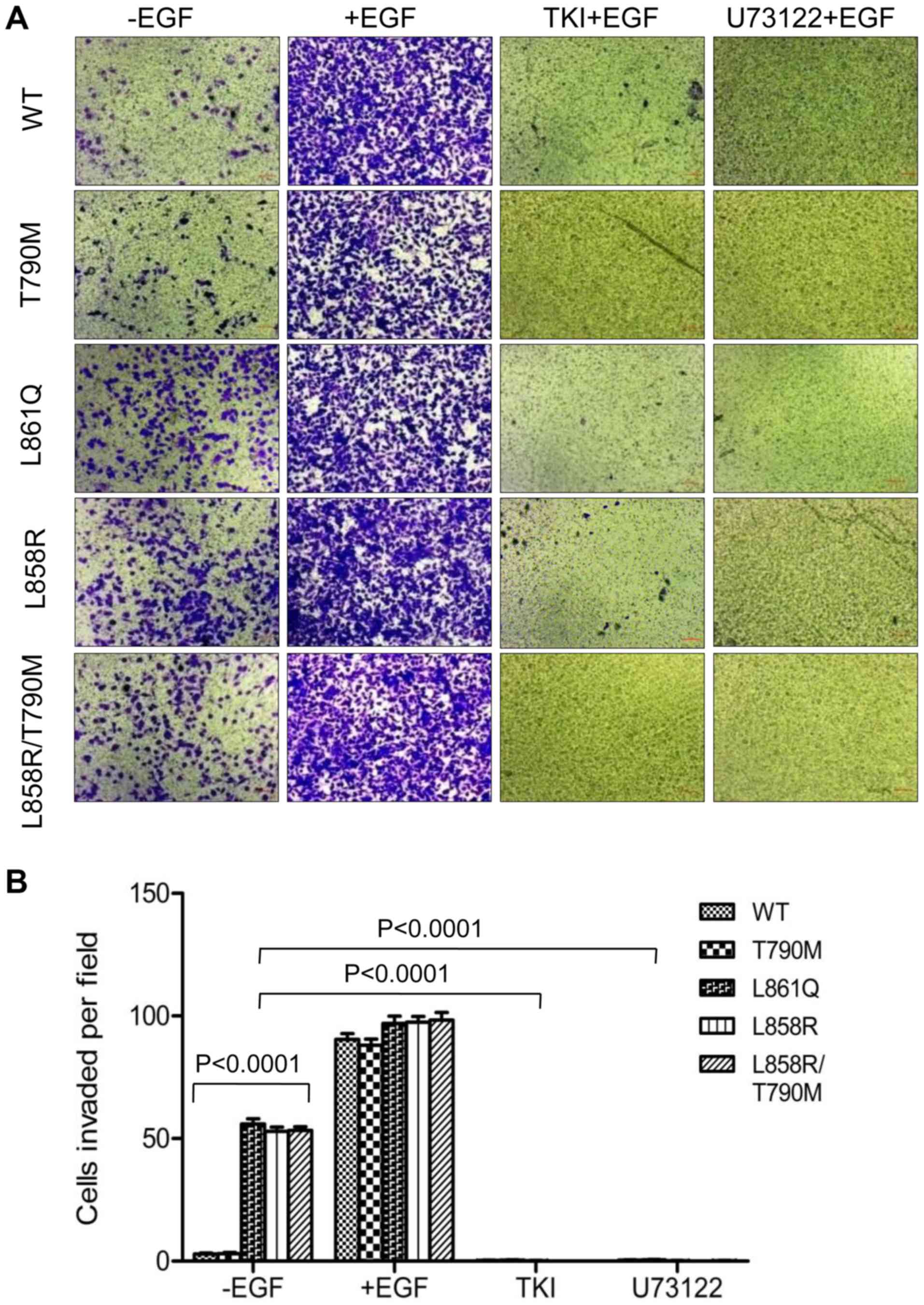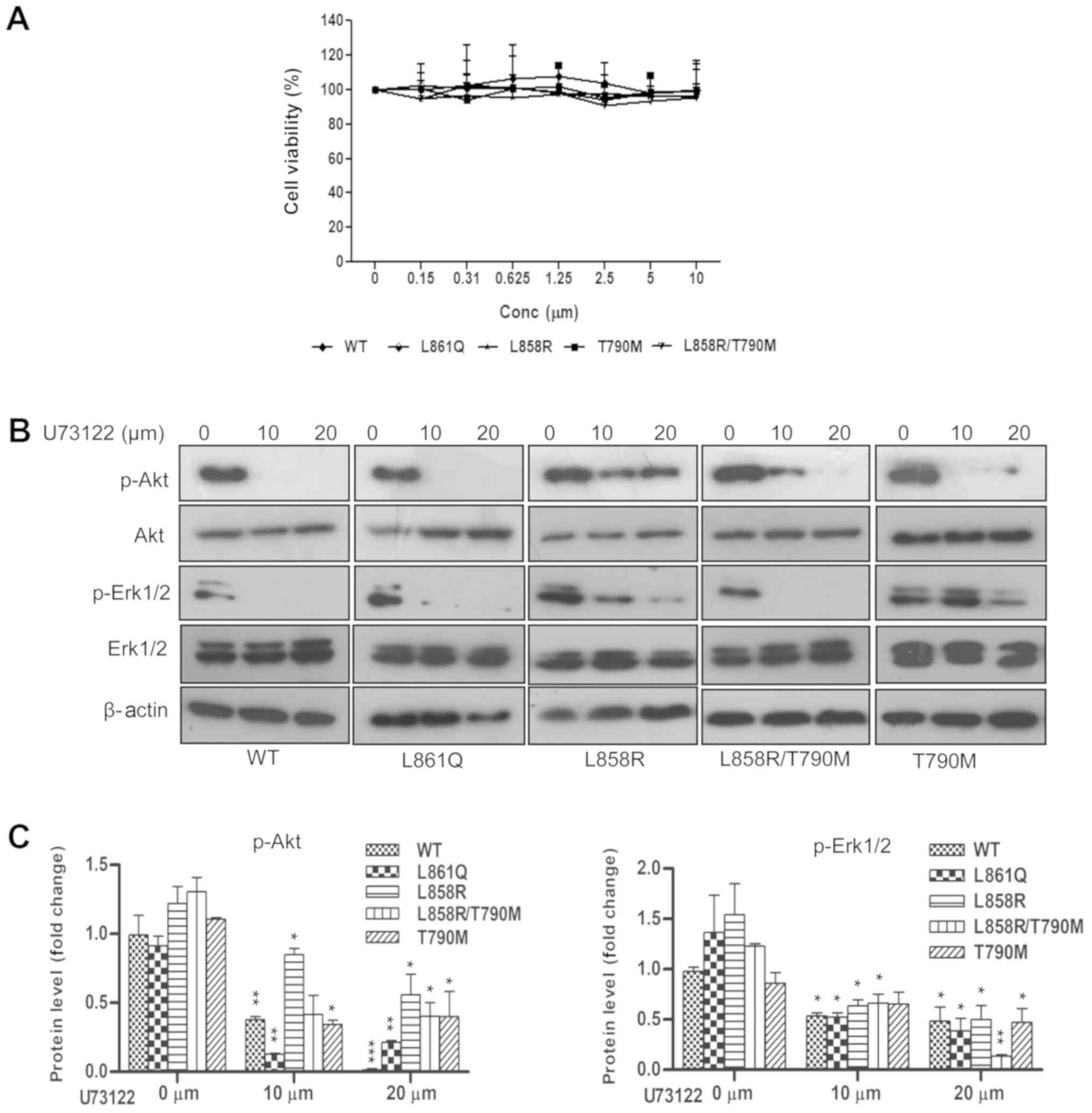PLCγ1‑dependent invasion and migration of cells expressing NSCLC‑associated EGFR mutants
- Authors:
- Published online on: August 19, 2020 https://doi.org/10.3892/ijo.2020.5112
- Pages: 989-1000
Abstract
Introduction
Non-small cell lung cancer (NSCLC) is the most common type of cancer and accounts for 85% of the total number of lung cancer cases. The delayed diagnosis of NSCLC renders treatment more difficult using surgical interventions and also renders the tumor insensitive to conventional chemotherapy (1). Over the past two decades, different expression patterns have been detected for various proteins, including epidermal growth factor receptor (EGFR) (2,3) and KRAS (4,5), which are associated with various types of lung cancer. The most common altered expression pattern is observed for EGFR, a membrane receptor tyrosine kinase in NSCLC tumors. Since this observation was made, the detection of EGFR mutations in patients with NSCLC has become an important test to predict the treatment response to the Food and Drug Administration (FDA)-approved tyrosine kinase inhibitors (TKIs), gefitinib and erlotinib. Patients with mutations in exon 19 and 21 of the receptor tyrosine kinase domain tend to have an improved outcome following treatment with these drugs (2,3,6). Nonetheless, the majority of patients develop secondary mutation. T790M in the ATP binding site of exon 20 confers drug resistance. Since the discovery of T790M, this amino acid change has become a major determinant of acquired resistance to first generation drugs (7-9). The 2nd generation TKIs targeting sensitive and resistant mutant receptors have exhibited promising results; however, they are associated with dose-limiting toxicity due to the inhibition of wild-type (Wt) EGFR signaling. Similarly, 3rd generation TKIs selectively and irreversibly target both resistant and sensitive mutant receptors with no effect or limited effects on the Wt receptor. Osimertinib, a 3rd generation TKI, has been approved by the FDA and the European Medicines Agency for the treatment of patients with NSCLC with EGFR-T790M mutations following the failure of 1st and 2nd generation TKIs (10-12). In spite of the availability of receptor targeted drugs and the consideration of receptor mutations for the treatment prediction, the prognosis of patients with advanced stage lung tumors remains poor.
Somatic mutations in the tyrosine kinase domain maintain the receptor constitutively active in a ligand-dependent and -independent manner, promoting several proliferative pathways which contribute to lung tumor cell proliferation and the evasion of programmed cell death (13,14). Tumor progression is generally associated with the invasion and metastasis of cancer cells, which is a complex process. The majority of studies on lung cancer-associated EGFR mutations are limited to the importance of kinase domain mutations for the prediction of the response of patients to TKIs. However, the functional dependence of signaling pathways recruited in the response to activated mutant receptor kinases for tumor progression and its connection with the metastatic potential of cells harboring EGFR mutations remains unclear. In the advanced stages of cancer, tumor cells leave the site of origin and invade various parts of the body. Most commonly, the invasion of cancer cells to the liver, lungs, brain and bones is the main reason for the mortality of patients with cancer. Thus, the diagnosis and treatment of metastasis varies with the original cancer type and is vital for treating the patient.
In the present study, the signaling pathways recruited in response to mutant receptor kinases, and their functional role in the invasive potential of cells expressing NSCLC associated EGFR mutants using 293 cells was investigated. Cells stably expressing receptor mutants sensitive to FDA-approved drugs, L858R and L861Q of exon 21, and 293 cells expressing resistant mutants, T790M of exon 20 and double-mutant-harboring L858R/T790M, were used in the present study. Furthermore, the regulatory role of mutant receptor-mediated phospholipase (PLC)γ1 in the invasive and migratory potential that signifies metastasis, was ascertained. The present study demonstrated an increased phosphorylation of PLCγ1 and other signaling molecules in cells expressing L858R, L861Q and L858R/T790M, compared to the Wt and T790M receptor. The inhibition of PLCγ1 phosphorylation following the reduction of receptor phosphorylation with TKI treatment confirms that PLCγ1 activation is driven by mutant receptors. A significant reduction in the in vitro migration and invasion of cells following TKI or PLC inhibitor treatment suggests that EGFR-mediated PLCγ1 activation may be crucial in maintaining the invasive phenotype of NSCLC tumor cells harboring EGFR mutations.
Materials and methods
Generation of EGFR mutants and stable cell lines
EGFR mutants; L861Q, L858R, T790M and double-mutant L858R/T790M were generated by introducing point mutations at desired locations in the full-length EGFR coding sequence in the CMV promoter driven eukaryotic expression vector, pcDNA3.1, as previously described (15). Clones were confirmed by sequencing. The 293 cell line was obtained from the National Centre for Cell Science (NCCS), India and 293 cells (with no endogenous EGFR expression) stably expressing mutant receptors were also generated using Lipofectamine 2000 (Invitrogen; Thermo Fisher Scientific, Inc.) following the manufacturer's instructions. Stable clones were selected with the neomycin analogue, G418 (Invitrogen; Thermo Fisher Scientific, Inc.) at a concentration of 600 µg/ml. Stable cells were cultured in Dulbecco's modified Eagle's medium (DMEM) supplemented with 10% fetal bovine serum (HiMedia Laboratories) and 300 µg of G418. The expression of Wt and mutant receptors in 293 cells was confirmed by western blot analysis using anti-EGFR anti-bodies (Santa Cruz Biotechnology, Inc.).
Western blot analysis
For western blot analysis, 293 cells stably expressing Wt and mutant receptors were grown to 80-90% confluency, followed by an overnight serum starvation. The following day, the cells were stimulated with 10 ng/ml recombinant human EGF (Sigma-Aldrich; Merck KGaA) for varying time points up to 30 min. Following treatment, the cells were lysed using 1X lysis buffer containing 150 mM NaCl, 20 mM Tris-HCl (pH 7.5), 1 mM Na2EDTA, 1 mM EGTA, 2.5 mM sodium pyrophosphate, 1% Triton X-100, 1 mM β-glycerophosphate, 1 mM sodium vanadate, 1 mM PMSF and 1 µg/ml leupeptin (Cell Signaling Technology, Inc.). The protein concentration was determined by Bradford assay; 20 µg of total protein from each sample was resolved using 10 % SDS-PAGE followed by western blot analysis. Blocking of non-specific proteins was performed by incubating the blots in 5% BSA or 5% skimmed milk in 1X TBST for 2 h at room temperature. The blots were incubated with anti-bodies against phospho-EGFR (Y1068) (cat. no. 3777, diluted 1:5,000), phospho-PLCγ1 (cat. no. 14008, diluted 1:5,000), phospho-Akt (cat. no. 4060, diluted 1:1,000), phospho-c-Cbl (cat. no. 8869, diluted 1:2,000), phospho-Erk1/2 (cat. no. 4370, diluted 1:5,000), phospho-Shc (cat. no. 2434, diluted 1:2,000), phospho-Gab1 (cat. no. 3233, diluted 1:2,000) (all from Cell Signaling Technology, Inc.) and β-actin (sc-47778, Santa Cruz Biotechnology, Inc.; diluted 1:6,000) in blocking buffer. Protein expression was detected using HRP-conjugated anti-rabbit (cat. no. A0545, diluted 1:10,000) or anti-mouse (cat. no. A4416, diluted 1:10,000) secondary antibodies (both from Sigma-Aldrich; Merck KGaA). Protein bands were visualized using ECL substrate (cat. no. 170-5060) obtained from Bio-Rad Laboratories Inc. The blots were stripped using a stripping buffer composed of 62.5 mM Tris-HCl (pH 6.8), 100 mM β-mercaptoethanol and 2% SDS at 55°C for 45 min and re-probed with antibodies against total PLCγ1 (cat. no. 5690, diluted 1:2,000; Cell Signaling Technology, Inc.), EGFR (sc-373746, diluted 1:2,000; Santa Cruz Biotechnology, Inc.) and c-Cbl (cat. no. 9794, diluted 1:1,000; Cell Signaling Technology, Inc.).
Treatment with TKI and U73122
The first-generation TKIs, gefitinib and erlotinib, the 2nd generation TKI, afatinib, and the 3rd generation drug, osimertinib (Biovision, Inc.), were used in the present study. TKIs were reconstituted in 99.5% DMSO and desired dilutions were made in fresh DMEM prior to use. The PLC inhibitor, U73122 (Sigma-Aldrich; Merck KGaA), was used to block PLC activity. U73122 was first dissolved in chloroform at 10 mg/ml. This was then aliquoted and purged with nitrogen gas to leave a thin, dry film and was stored at −20°C. Immediately prior to the experiment, one vial was removed from −20°C and reconstituted with 99.5% DMSO to make a 5 mM stock solution. Working dilutions were made in serum-free medium. For inhibitor experiments, 293 cells expressing Wt and mutant receptors were grown to 90% confluency, serum-starved overnight and treated with TKIs (erlotinib, 100 nm; gefitinib, 100 nm; afatinib, 50 nm; and osimertinib, 50 nm) for 2 h or for 25 min with PLC inhibitor at concentrations of 0, 10 and 20 µm. This was followed by stimulation with 10 ng/ml recombinant human EGF for 10 min. Equal amounts of total protein from each sample was analyzed for EGFR and PLCγ1 phosphorylation as described above in the western blot analysis section.
Wound healing assay
Cells expressing Wt or mutant receptors were plated in 12-well plates and grown to 90% confluency. Cells were then starved overnight and a wound was generated by scratching the confluent monolayer using a sterile micropipette tip. Media was replaced with fresh medium containing 0.1% FBS, 200 nM TKI or 3 µM U73122 in the absence or presence of EGF (10 ng/ml). DMSO was used as a control. Images were captured at 0 and 24 h post-treatment with a digital microscopic camera, DC5 (Magnus) connected to an inverted microscope (Nikon ECLIPSE, TS-100, Nikon Healthcare Japan Inc.) and wound closure was measured using ImageJ software (ImageJ 1.46r, National Institute for Health) (16). A total of 6 measurements per image were acquired and the average gap distance was calculated. Results are presented as a mean of two different experiments.
Boyden chamber assay
Boyden chambers with 6.5 mm diameter polycarbonate filters of 8 µm pore size (BD Biosciences) were used in the present study. Wt or mutant receptor-expressing cells were grown as mentioned above and serum starved. Following serum starvation, the cells were trypsinized and 4×104 cells were suspended in serum-free DMEM containing 200 nM TKI or 3 µM U73122 or DMSO and EGF (10 ng/ml). A total of 200 µl of the cell suspension was added to the upper chamber of a Transwell insert, placed in a 24-well plate and cells were allowed to settle down for 5 min. Subsequently, 700 µl of 10% FBS was added to the lower chamber of the Transwell insert as a chemoattractant and the cells were incubated at 37°C in 5% CO2. At 24 h post-incubation, the Transwell inserts were removed from 24-well plates and non-migrated cells from the upper chamber were removed using a cotton swab. The cells that had migrated through the membrane were stained with 0.1% crystal violet (Thermo Fisher Scientific, Inc.) at room temperature for 1 h. Stained cells were counted at a higher magnification from 6 different representative fields using a phase contrast inverted microscope (Nikon Healthcare Japan Inc.). Data are represented as the means ± SEM from 3 independent experiments.
Matrigel invasion assay
For invasion assays, stock solution of 8.5 mg/ml Matrigel was thawed overnight on ice in 4°C refrigerator. The following day, Matrigel was diluted to a concentration of 0.3 mg/ml in serum-free DMEM using pre-chilled tips and tubes. A total of 40 µl of Matrigel was added to the upper chamber of a Transwell insert in 24-well plate and allowed to solidify for 1 h at 37°C in 5% CO2 to form a thin Matrigel layer. The cell suspension containing 4×104 cells was added on top of the Matrigel layer to facilitate invasion. Following 24 h of incubation at 37°C in 5% CO2, invading cells were stained and counted as described above. Data are shown as the means ± SEM from 3 independent experiments.
MTT assay
Cell viability was measured using MTT assays. In brief, 293 cells stably expressing Wt and mutant receptors were cultured in 96-well plates in triplicates at a density of 10,000 cells/well. After 24 h, growth medium was replaced with maintenance medium containing either PLC inhibitor, U73122 or DMSO (vehicle control). At 48 h post-drug treatment, the cells were incubated with 20 µl of 5 mg/ml MTT at 37°C in 5% CO2 for 3 h. MTT reagent was then aspirated off and formazan crystals were dissolved in 200 µl of DMSO. The absorbance was recorded at a 560 and 670 nm wavelength on a SpectroMax Plus 384 microplate reader (Molecular Devices, LLC). The percentage cell viability was calculated using the following formula: OD of treated cells − blank/OD of untreated cells − blank ×100 and plotted against the concentration of the drug. Data are presented as the means ± SD using GraphPad Prism software (GraphPad Software, Inc.).
Soft agar colony formation assay
The anchorage-independent growth of cells expressing mutant receptors was determined using soft agar assays. The bottom layer of 0.8% agarose was created by mixing equal volumes of 1.6% low melting agarose, 2X DMEM supplemented with 20% FBS and 2X antibiotics to give a solution of 0.8% agar + 1X medium + 10% FBS + 1X antibiotics. A total of 1.5 ml of the solution was poured into each well of 6-well plates and allowed to solidify for 30 min at room temperature. Cells expressing Wt or mutant receptors were trypsinized and were suspended at the rate of 5,000 cells/well into 750 µl of 2X culture medium containing 1 µM TKI or 10 µM U73122, 10 ng/ml EGF and G418. This solution was then mixed with 750 µl of 0.8% low melting agarose to make the concentration of agarose 0.4%. Immediately, the cell suspension was poured over the solidified bottom layer and the plate was incubated at 37°C in 5% CO2 for 9-10 days. Cells were fed with 200 µl of culture medium twice a week to prevent the desiccation and deprivation of nutrients. After 10 days, colonies were stained with 0.005% crystal violet (Thermo Fisher Scientific, Inc.) for 30 min at room temperature. Images were captured using an inverted microscope (Nikon Healthcare Japan Inc.) and colonies were counted using ImageJ software (ImageJ 1.46r, NIH).
Statistical analysis
Data analysis was carried out using GraphPad Prism v.5.0 software (GraphPad Software, Inc.). One-way ANOVAs (Tukey's post hoc test for multiple comparisons) were applied to assess the significance of differences between samples and a P-value <0.05 was considered to indicate a statistically significant difference.
Results
Activation of mutant EGFR induces the increased phosphorylation of PLCγ1 and other signaling molecules
Cells stably expressing TKI sensitizing mutants, L861Q, L858R; resistant mutants, T790M, L858R/T790M (double-mutant) and Wt receptor were analyzed for their activation and recruited signaling molecules in response to receptor phosphorylation. The activation of mutant receptors following EGF stimulation at different time points resulted in an increased phosphorylation of PLCγ1 in 293 cells. The absence of EGF also increased the phosphorylation of mutant receptor and PLCγ1. The phosphorylation of PLCγ1 in cells expressing receptor mutants independent of each other, exhibited an association with the corresponding receptor phosphorylation. These experiments confirmed the activation of mutant receptors in a ligand-dependent/independent manner and mutant receptor-driven PLCγ1 phosphorylation (Fig. 1). The total PLCγ1, EGFR and β-actin levels remained unaltered in all samples. Furthermore, signaling molecules, such as Akt, Erk1/2 and c-Cbl, and the adaptor proteins, Gab1 and Shc, also exhibited an increased phosphorylation following EGF stimulation (Fig. S1A and B).
Inhibition of EGFR activity by TKIs abrogates PLCγ1 phosphorylation
Mutant receptor-mediated PLCγ1 phosphorylation was measured in the presence of FDA-approved EGFR-targeted drugs (TKIs). Cells expressing mutant receptors were treated with the desired concentrations of 1st, 2nd and 3rd generation TKIs. Cells were serum-starved overnight followed by EGF stimulation for 10 min and TKI treatment for 2 h. The phosphorylation of PLCγ1, as examined by western blot analysis, was shown to be reduced following the inhibition of receptor phosphorylation by TKIs, demonstrating that PLCγ1 activation is mutant receptor-driven (Fig. 2). Conversely, treatment of the cells with the PLC inhibitor, U73122, had no marked effect on EGFR and PLCγ1 phosphorylation (Fig. 3). Treatment with TKIs resulted in the inhibition of the aforementioned signaling molecules, suggesting that these are recruited in response to mutant receptor activation (data not shown).
PLCγ1-mediated migration and invasion of cells expressing mutant receptors
PLCγ1 is a known regulator of tumor progression and cell migration activated by receptor tyrosine kinase signaling (17,18). The role of PLCγ1 in the migration and invasion of cells expressing NSCLC-associated receptor mutants was determined using wound healing and Boyden chamber assays. Wound healing assays were carried out in cells expressing L861Q, L858R, L858R/T790M, T790M and Wt receptor treated with TKIs or the PLC inhibitor, U73122 with or without EGF stimulation. Afatinib, a 2nd generation TKI, was only used to inhibit receptor phosphorylation in this experiment, as it has been approved for the treatment of NSCLC tumors with resistant mutations. It has also been shown to be effective against tumors harboring both common and uncommon EGFR mutations in vitro (19) and in clinical settings (20).
Wounds were generated using a micropipette tip and wound closure was measured using ImageJ software at 0 and 24 h post-incubation. In the absence of EGF, cells expressing L861Q, L858R and L858R/T790M mutants migrated out to fill the gap, thus closing the wound. Cells expressing Wt or T790M mutant did not exhibit any marked migration, leaving the gap unfilled. The extent of the migration of the cells is illustrated in Fig. 4A. EGF stimulation at the concentration of 10 ng/ml induced the migration of cells expressing Wt and resistant mutant T790M as well, subsequently leading to wound closure (Fig. 4B). However, treatment with TKIs and PLC inhibitor blocked cell migration, irrespective of EGF stimulation (Figs. S2-S6).
Similar results were obtained with Boyden chamber migration and invasion assays. In the absence of EGF, the migration of cells expressing mutant receptors through Transwell inserts further confirmed the role of the ligand-independent activation of mutant EGFR and PLCγ1 signaling in cell migration and invasion. Treatment with afatinib at a concentration of 200 nM and U73122 at 3 µM followed by EGF stimulation, inhibited the migration (Fig. 5) and invasion (Fig. 6) of cells expressing Wt and mutant receptors. Taken together, these data demonstrate that mutant receptor driven PLCγ1 is a potential regulator of invasive and migratory potential of NSCLC cells harboring EGFR mutations.
PLC inhibitor, U73122, does not inhibit the proliferation of cells expressing EGFR mutants
The inhibition of proliferation of NSCLC tumors harboring EGFR mutations with TKI treatment is a well-established fact. In the present study, the role of PLCγ1 in tumor cell proliferation and invasion was determined with the PLC inhibitor, U73122, following EGF stimulation. Treatment of cells with U73122 for 25 min significantly reduced the invasion and migration of 293 cells expressing both TKI sensitive and resistant mutants as aforementioned. Nonetheless, no effect of PLC inhibitor treatment on cell viability was observed. Cells were observed to be 100% viable after 48 h following U73122 treatment, as assessed by MTT assays (Fig. 7A). Upon validation of the signaling pathways, U73122 treatment for 25 min at 10-20 µM inhibited Akt and Erk1/2 phosphorylation transiently, whereas it increased the phosphorylation of both these signaling molecules was observed following 48 h of drug treatment. This suggested that cells can maintain their proliferative potential independent of PLC activation (Fig. 7B).
The effect of PLC inhibitor on cell proliferation was validated using soft agar colony formation assays. Cells expressing Wt and mutant receptors treated with 10 µM U73122, a higher concentration than the concentration used for the invasion and migration assays, exhibited no significant reduction in colony size compared to the untreated cells (Fig. S7). This experiment confirmed that PLCγ1 may not have a direct regulatory role on the proliferation of cells expressing NSCLC associated EGFR mutants, irrespective of EGF stimulation. Cells treated with 1µM TKIs were included in this assay as a positive control. The anchorage independent colony forming ability of 293 cells expressing receptor mutants was reduced following treatment with TKIs. Treatment with U73122 did not inhibit the formation of colonies, further identifying that PLCγ1 may be a downstream component of activated EGFR. In addition, no significant effect of U73122 on Akt and Erk1/2, cell survival signaling pathways was observed up to 48 h post-treatment (Fig. S8). However, this experiment was performed once, as it was already confirmed that U73122 exerted no inhibitory effect on cell proliferation by soft agar assay.
Discussion
Receptor tyrosine kinase activity, induced upon ligand binding, recruits various signaling pathways and downstream molecules which are regulators of cell survival and growth. The dysregulated activity of receptors, due to mutations in its kinase domain, is one of the mechanisms involved in the progression of a number of tumors, including lung cancer types. In the present study, the signaling molecules recruited in response to NSCLC-associated EGFR mutations in a ligand-dependent and -independent manner in the 293 cell line were evaluated. It is a non-endogenous EGFR-expressing cell line and is considered EGFR-negative. It was used as a negative control for the comparison of EGFR expression in lung cancer cell lines expressing EGFR (21). Thus, the 293 cell line with a EGFR null background was used to investigate the effects of EGFR mutants on molecular signaling. The present study demonstrated an increased phosphorylation of the signaling molecules, PLCγ1, c-Cbl, Stat, Erk1/2, Akt, Shc and Gab1, in response to altered EGFR activity and the abrogation of their phosphorylation following treatment with TKIs. These signaling molecules are known to be involved in a number of biological processes that are essential for tumor cell proliferation, survival, migration and invasion. Both Gab1 and Shc are adaptor proteins, essential for the receptor-activated Erk1/2, Akt and Stat pathways (22,23). c-Cbl is an ubiquitin ligase that plays an important role in ligand-dependent receptor ubiquitination (24). The results from the present study are in agreement with those of earlier reports, in which the induction of signaling pathways was demonstrated in response to NSCLC-associated EGFR mutant kinase activity (13,14). The mutant receptor remains constitutively active and leads to malignant cell survival, tumor progression, migration and metastasis.
The induction of tumor cell migration is a foremost step in tumor metastasis, and it is evident from a number of studies that PLCγ1 is highly expressed in invasive tumors, such as metastatic colorectal cancer cells (25) and breast carcinoma (26). PLCγ1 plays a regulatory role in cell proliferation, invasion and metastasis in various other cancer types (17,18). PLCγ1 is a lipase and isozyme of the phosphoinositide specific PLC family. It is a multi-domain protein consisting of two pleckstrin homology (PH), two Src homology 2 (SH2), one Src homology 3 (SH3) and two catalytic domains. PLCγ1 signaling is induced by growth factors, such as EGF (27), PDGF (28) and IGF (29) following the increased activity of their respective receptors, and subsequently contributes to enhanced cell motility (30,31). PLCγ1 binds directly with activated EGFR through its SH2 domain (32). EGFR then phosphorylates PLCγ1 at its tyrosine residues and activates its lipase activity. Activated PLCγ1 hydrolyzes phosphatidylinositol 4, 5-bispho-sphate (PIP2) to give two secondary messengers, inositol 1, 4, 5-triphosphate (IP3) and diacylglycerol (DAG). IP3 is important for the transient increase in intracellular Ca2+, while DAG activates protein kinase C (PKC). These processes are essential for cell proliferation, invasion and migration.
Previous studies have demonstrated a fundamental role of the EGFR family members for PLCγ1 activation in tumor cell motility and metastasis control (33). However, NSCLC-associated EGFR mutant-driven PLCγ1 activation and its role in cell invasion and migration is currently unknown. The migration of tumors from the site of origin is the primary cause of the majority of cancer-related mortality. In the present study, NSCLC-associated EGFR mutant-driven PLCγ1 phosphorylation and its functional role in cell invasion and migration was demonstrated. Following EGF stimulation, 293 cells expressing L861Q, L858R and double-mutant L858R/T790M exhibited an increased phosphorylation of PLCγ1, as compared to the drug-resistant mutant, T790M and Wt receptor. Phospho-PLCγ1 levels were associated with the corresponding mutant receptor phosphorylation levels in 293 cells. Receptor mutant-recruited PLCγ1-mediated cell invasion and migration was validated using wound healing assays, Transwell cell migration assays and invasion assays using TKIs and the PLC inhibitor, U73122. These experiments together demonstrated NSCLC-associated EGFR mutant-driven PLCγ1 activation in 293 cells. NSCLC patients commonly develop TKI resistance due to a variety of reasons. The most commonly reported is the development of secondary mutations in the exon 20 region of receptor kinase domain (7-9). Patients not presenting T790M mutations develop resistance due to the modulation of other proliferative signal pathways (34-38) resulting in enhanced tumor progression.
PLCγ1 is the downstream signaling molecule of activated receptor kinase by growth factors and plays a significant role in the intracellular signaling to modulate cell proliferation and growth (39). Its role in the induction of proliferation was investigated by inhibiting its lipase activity in 293 cells expressing receptor mutants. Treatment of the cells with U73122 inhibited cell migration and invasion with no notable effect on EGFR and PLCγ1 phosphorylation. Similarly, following U73122 treatment, no effect on cell proliferation was observed. This may be due to the fact that cell proliferation depends upon interactions between PLCγ1 protein and other effector molecules instead of its lipase activity as the PLC inhibitor, U73122, is known to inhibit its lipase activity (40). A study by Xie et al also reported that the catalytic activity of PLCγ1 is required for the EGF-induced migration of squamous cell carcinoma cells (41).
Akt and Erk1/2 pathways were inhibited within 25 min of U73122 treatment followed by EGF stimulation, although the cells remained viable even after 48 h of drug treatment. In association with cell viability, the increased phosphorylation of survival signaling molecules, Akt and Erk1/2 were recorded. This indicates that the inhibition of PLCγ1 catalytic activity by U73122 may attenuate the recruitment of survival signals soon after its addition; however, this effect may be nullified by other mechanisms, which warrant further investigation. EGFR directly activates PLCγ1 and indirectly activates Akt. Both these signaling molecules are important in intracellular signaling. One is involved in metastasis and the other one in proliferation, respectively The interaction of phospho-PLCγ1 with Akt in EGF-stimulated receptor tyrosine kinase activation in metastasis has been previously reported (32). In the present study, the interaction between phospho-PLCγ1 and Akt in 293 cells expressing receptor mutants was not examined; however, whether these two proteins associate or not and whether their association has any significance in the regulation of cell proliferation is another aspect that warrants investigation. It is evident from the present study that PLC inhibitors do not impose any negative effect on mutant receptor activity; therefore, it remains constitutively active and recruits survival signals. This allows cells to enter the proliferative mode within a short period even in the presence of PLC inhibitor. As discussed by Jang et al, phospho-PLCγ1 likely interacts with other signaling molecules to maintain the cells in a proliferative mode, as PLC inhibitor has no effect on PLCγ1 phosphorylation (40).
Similar effects have been reported in HNSCC and prostate cancer cells where the inactivation of PLCγ1 inhibited cell invasion without affecting the cell growth and tumor volume in vitro and in vivo, respectively (42,43). On the contrary, in human gastric adenocarcinoma cells, PLCγ1-dependent proliferation was reported beyond its role in cell migration (44), although the upregulation of PLCγ1 was negatively associated with the survival of patients with hepatocellular carcinoma. It exerts an oncogenic effect and induces HCC tumorigenesis through Erk1/2 and NF-kB pathways (45). The suppression of PLCγ1 prevents the phosphorylation of NF-κB and Erk1/2 activation. It was has also been demonstrated to be involved in colorectal tumorigenesis (46). PLCγ1 has been established as a key modulator of migration and invasion of various tumor types. However, the detailed mechanism of action for PLCγ1 mediated tumor proliferation needs to be explored in various cancer types including lung cancer.
In conclusion, the results of the present study demon-strated that mutant receptor-recruited PLCγ1 activation mediates the invasion and migration of 293 cells expressing NSCLC-associated EGFR mutants. Nonetheless, constitutively active mutant receptor overcomes the effects induced by the inhibition of PLCγ1 lipase activity, recruiting proliferative signals to keep the cells viable. Considering the aforementioned results, PLCγ1 may be considered as a drug target upon validation and confirmation in more lung cancer cell lines with NSCLC-associated EGFR mutations in combination with other therapeutics to increase the disease-free survival of patients with NSCLC.
Supplementary Data
Acknowledgments
The authors acknowledge the University Grants Commission for fellowship of the first author and Jawaharlal Nehru University for providing infrastructure and facilities.
Funding
The present study was supported by the Indian Council of Medical Research (Project No. 5/13/94/2008-NCD- III) and DST-PURSE, New Delhi, India.
Availability of data and materials
The datasets used and/or analyzed during the current study are available from the corresponding author on reasonable request.
Authors' contributions
MSR designed the study and supervised the work. SM, AK, AMJ performed the experiments. MSR and SM analyzed the data and prepared the manuscript. All the authors read approved the final manuscript.
Ethics approval and consent to participate
Not applicable.
Patient consent for publication
Not applicable.
Competing interests
The authors declare that they have no competing interests.
References
|
Chen Z, Fillmore CM, Hammerman PS, Kim CF and Wong K-K: Non-small-cell lung cancers: A heterogeneous set of diseases. Nat Rev Cancer. 14:535–546. 2014. View Article : Google Scholar : PubMed/NCBI | |
|
Paez JG, Jänne PA, Lee JC, Tracy S, Greulich H, Gabriel S, Herman P, Kaye FJ, Lindeman N, Boggon TJ, et al: EGFR mutations in lung cancer: correlation with clinical response to gefitinib therapy. Science. 304:1497–1500. 2004. View Article : Google Scholar : PubMed/NCBI | |
|
Lynch TJ, Bell DW, Sordella R, Gurubhagavatula S, Okimoto RA, Brannigan BW, Harris PL, Haserlat SM, Supko JG, Haluska FG, et al: Activating mutations in the epidermal growth factor receptor underlying responsiveness of non-small-cell lung cancer to gefitinib. N Engl J Med. 350:2129–2139. 2004. View Article : Google Scholar : PubMed/NCBI | |
|
Eberhard DA, Johnson BE, Amler LC, Goddard AD, Heldens SL, Herbst RS, Ince WL, Jänne PA, Januario T, Johnson DH, et al: Mutations in the epidermal growth factor receptor and in KRAS are predictive and prognostic indicators in patients with non-small-cell lung cancer treated with chemotherapy alone and in combination with erlotinib. J Clin Oncol. 23:5900–5909. 2005. View Article : Google Scholar : PubMed/NCBI | |
|
Lièvre A, Bachet J-B, Le Corre D, Boige V, Landi B, Emile JF, Côté JF, Tomasic G, Penna C, Ducreux M, et al: KRAS mutation status is predictive of response to cetuximab therapy in colorectal cancer. Cancer Res. 66:3992–3995. 2006. View Article : Google Scholar : PubMed/NCBI | |
|
Raymond E, Faivre S and Armand JP: Epidermal growth factor receptor tyrosine kinase as a target for anticancer therapy. Drugs. 60(Suppl 1): 15–23; discussion 41–42. 2000. View Article : Google Scholar : PubMed/NCBI | |
|
Nguyen K-SH, Kobayashi S and Costa DB: Acquired resistance to epidermal growth factor receptor tyrosine kinase inhibitors in non-small-cell lung cancers dependent on the epidermal growth factor receptor pathway. Clin Lung Cancer. 10:281–289. 2009. View Article : Google Scholar : PubMed/NCBI | |
|
Kobayashi S, Boggon TJ, Dayaram T, Jänne PA, Kocher O, Meyerson M, Johnson BE, Eck MJ, Tenen DG and Halmos B: EGFR mutation and resistance of non-small-cell lung cancer to gefitinib. N Engl J Med. 352:786–792. 2005. View Article : Google Scholar : PubMed/NCBI | |
|
Oxnard GR, Arcila ME, Sima CS, Riely GJ, Chmielecki J, Kris MG, Pao W, Ladanyi M and Miller VA: Acquired resistance to EGFR tyrosine kinase inhibitors in EGFR-mutant lung cancer: Distinct natural history of patients with tumors harboring the T790M mutation. Clin Cancer Res. 17:1616–1622. 2011. View Article : Google Scholar | |
|
Liao B-C, Lin C-C and Yang JC-H: Second and third-generation epidermal growth factor receptor tyrosine kinase inhibitors in advanced nonsmall cell lung cancer. Curr Opin Oncol. 27:94–101. 2015. View Article : Google Scholar : PubMed/NCBI | |
|
Jänne PA, Yang JC-H, Kim D-W, Planchard D, Ohe Y, Ramalingam SS, Ahn MJ, Kim SW, Su WC, Horn L, et al: AZD9291 in EGFR inhibitor-resistant non-small-cell lung cancer. N Engl J Med. 372:1689–1699. 2015. View Article : Google Scholar : PubMed/NCBI | |
|
Cross DAE, Ashton SE, Ghiorghiu S, Eberlein C, Nebhan CA, Spitzler PJ, Orme JP, Finlay MR, Ward RA, Mellor MJ, et al: AZD9291, an irreversible EGFR TKI, overcomes T790M-mediated resistance to EGFR inhibitors in lung cancer. Cancer Discov. 4:1046–1061. 2014. View Article : Google Scholar : PubMed/NCBI | |
|
Sordella R, Bell DW, Haber DA and Settleman J: Gefitinib-sensitizing EGFR mutations in lung cancer activate anti-apoptotic pathways. Science. 305:1163–1167. 2004. View Article : Google Scholar : PubMed/NCBI | |
|
Kim Y, Apetri M, Luo B, Settleman JE and Anderson KS: Differential effects of tyrosine kinase inhibitors on normal and oncogenic EGFR signaling and downstream effectors. Mol Cancer Res. 13:765–774. 2015. View Article : Google Scholar : PubMed/NCBI | |
|
Kamath A, Joseph AM, Gupta K, Behera D, Jaiswal A, Dewan R and Rajala MS: Proteomic analysis of HEK293 cells expressing non small cell lung carcinoma associated epidermal growth factor receptor variants reveals induction of heat shock response. Exp Hematol Oncol. 4:162015. View Article : Google Scholar : PubMed/NCBI | |
|
Rasband WS: US National Institutes of Health, MD, USA. http://imagejnih.gov/ij/uri. 2011, Accessed August 28, 2008. | |
|
Piccolo E, Innominato PF, Mariggio MA, Maffucci T, Iacobelli S and Falasca M: The mechanism involved in the regulation of phospholipase Cgamma1 activity in cell migration. Oncogene. 21:6520–6529. 2002. View Article : Google Scholar : PubMed/NCBI | |
|
Wells A and Grandis JR: Phospholipase C-γ1 in tumor progression. Clin Exp Metastasis. 20:285–290. 2003. View Article : Google Scholar | |
|
Li D, Ambrogio L, Shimamura T, Kubo S, Takahashi M, Chirieac LR, Padera RF, Shapiro GI, Baum A, Himmelsbach F, et al: BIBW2992, an irreversible EGFR/HER2 inhibitor highly effective in preclinical lung cancer models. Oncogene. 27:4702–4711. 2008. View Article : Google Scholar : PubMed/NCBI | |
|
Kobayashi Y and Mitsudomi T: Not all epidermal growth factor receptor mutations in lung cancer are created equal: Perspectives for individualized treatment strategy. Cancer Sci. 107:1179–1186. 2016. View Article : Google Scholar : PubMed/NCBI | |
|
Zhang F, Wang S, Yin L, Yang Y, Guan Y, Wang W, Xu H and Tao N: Quantification of epidermal growth factor receptor expression level and binding kinetics on cell surfaces by surface plasmon resonance imaging. Anal Chem. 87:9960–9965. 2015. View Article : Google Scholar : PubMed/NCBI | |
|
Yart A, Laffargue M, Mayeux P, Chretien S, Peres C, Tonks N, Roche S, Payrastre B, Chap H and Raynal P: A critical role for phosphoinositide 3-kinase upstream of Gab1 and SHP2 in the activation of ras and mitogen-activated protein kinases by epidermal growth factor. J Biol Chem. 276:8856–8864. 2001. View Article : Google Scholar : PubMed/NCBI | |
|
Hashimoto A, Kurosaki M, Gotoh N, Shibuya M and Kurosaki T: Shc regulates epidermal growth factor-induced activation of the JNK signaling pathway. J Biol Chem. 274:20139–20143. 1999. View Article : Google Scholar : PubMed/NCBI | |
|
Shtiegman K, Kochupurakkal BS, Zwang Y, Pines G, Starr A, Vexler A, Citri A, Katz M, Lavi S, Ben-Basat Y, et al: Defective ubiquitinylation of EGFR mutants of lung cancer confers prolonged signaling. Oncogene. 26:6968–6978. 2007. View Article : Google Scholar : PubMed/NCBI | |
|
Nomoto K, Tomita N, Miyake M, Xhu DB, LoGerfo PR and Weinstein IB: Expression of phospholipases γ1, β1, and δ1 in primary human colon carcinomas and colon carcinoma cell lines. Mol Carcinog. 12:146–152. 1995. View Article : Google Scholar : PubMed/NCBI | |
|
Arteaga CL, Johnson MD, Todderud G, Coffey RJ, Carpenter G and Page DL: Elevated content of the tyrosine kinase substrate phospholipase C-gamma 1 in primary human breast carcinomas. Proc Natl Acad Sci USA. 88:10435–10439. 1991. View Article : Google Scholar : PubMed/NCBI | |
|
Chen P, Xie H, Sekar MC, Gupta K and Wells A: Epidermal growth factor receptor-mediated cell motility: Phospholipase C activity is required, but mitogen-activated protein kinase activity is not sufficient for induced cell movement. J Cell Biol. 127:847–857. 1994. View Article : Google Scholar : PubMed/NCBI | |
|
Kundra V, Escobedo JA, Kazlauskas A, Kim HK, Rhee SG, Williams LT and Zetter BR: Regulation of chemotaxis by the platelet-derived growth factor receptor-β. Nature. 367:474–476. 1994. View Article : Google Scholar : PubMed/NCBI | |
|
Bornfeldt KE, Raines EW, Nakano T, Graves LM, Krebs EG and Ross R: Insulin-like growth factor-I and platelet-derived growth factor-BB induce directed migration of human arterial smooth muscle cells via signaling pathways that are distinct from those of proliferation. J Clin Invest. 93:1266–1274. 1994. View Article : Google Scholar : PubMed/NCBI | |
|
Wells A, Kassis J, Solava J, Turner T and Lauffenburger DA: Growth factor-induced cell motility in tumor invasion. Acta Oncol. 41:124–130. 2002. View Article : Google Scholar : PubMed/NCBI | |
|
Polk DB: Epidermal growth factor receptor-stimulated intestinal epithelial cell migration requires phospholipase C activity. Gastroenterology. 114:493–502. 1998. View Article : Google Scholar : PubMed/NCBI | |
|
Wang Y, Wu J and Wang Z: Akt binds to and phosphorylates phospholipase C-gamma1 in response to epidermal growth factor. Mol Biol Cell. 17:2267–2277. 2006. View Article : Google Scholar : PubMed/NCBI | |
|
Appert-Collin A, Hubert P, Crémel G and Bennasroune A: Role of ErbB receptors in cancer cell migration and invasion. Front Pharmacol. 6:2832015. View Article : Google Scholar : PubMed/NCBI | |
|
Sos ML, Koker M, Weir BA, Heynck S, Rabinovsky R, Zander T, Seeger JM, Weiss J, Fischer F, Frommolt P, et al: PTEN loss contributes to erlotinib resistance in EGFR-mutant lung cancer by activation of Akt and EGFR. Cancer Res. 69:3256–3261. 2009. View Article : Google Scholar : PubMed/NCBI | |
|
Bidkhori G, Moeini A and Masoudi-Nejad A: Modeling of tumor progression in NSCLC and intrinsic resistance to TKI in loss of PTEN expression. PLoS One. 7:e480042012. View Article : Google Scholar : PubMed/NCBI | |
|
Kanda R, Kawahara A, Watari K, Murakami Y, Sonoda K, Maeda M, Fujita H, Kage M, Uramoto H, Costa C, et al: Erlotinib resistance in lung cancer cells mediated by integrin β1/Src/Akt-driven bypass signaling. Cancer Res. 73:6243–6253. 2013. View Article : Google Scholar : PubMed/NCBI | |
|
Engelman JA, Zejnullahu K, Mitsudomi T, Song Y, Hyland C, Park JO, Lindeman N, Gale CM, Zhao X, Christensen J, et al: MET amplification leads to gefitinib resistance in lung cancer by activating ERBB3 signaling. Science. 316:1039–1043. 2007. View Article : Google Scholar : PubMed/NCBI | |
|
Pao W, Wang TY, Riely GJ, Miller VA, Pan Q, Ladanyi M, Zakowski MF, Heelan RT, Kris MG and Varmus HE: KRAS mutations and primary resistance of lung adenocarcinomas to gefitinib or erlotinib. PLoS Med. 2:e172005. View Article : Google Scholar : PubMed/NCBI | |
|
Wahl M and Carpenter G: Selective phospholipase C activation. BioEssays. 13:107–113. 1991. View Article : Google Scholar : PubMed/NCBI | |
|
Jang H-J, Suh P-G, Lee YJ, Shin KJ, Cocco L and Chae YC: PLCγ1: Potential arbitrator of cancer progression. Adv Biol Regul. 67:179–189. 2018. View Article : Google Scholar | |
|
Xie Z, Peng J, Pennypacker SD and Chen Y: Critical role for the catalytic activity of phospholipase C-gamma1 in epidermal growth factor-induced cell migration. Biochem Biophys Res Commun. 399:425–428. 2010. View Article : Google Scholar : PubMed/NCBI | |
|
Davies G, Martin TA, Ye L, Lewis-Russell JM, Mason MD and Jiang WG: Phospholipase-C gamma-1 (PLCγ-1) is critical in hepatocyte growth factor induced in vitro invasion and migration without affecting the growth of prostate cancer cells. Urol Oncol. 26:386–391. 2008. View Article : Google Scholar : PubMed/NCBI | |
|
Thomas SM, Coppelli FM, Wells A, Gooding WE, Song J, Kassis J, Drenning SD and Grandis JR: Epidermal growth factor receptor-stimulated activation of phospholipase Cgamma-1 promotes invasion of head and neck squamous cell carcinoma. Cancer Res. 63:5629–5635. 2003.PubMed/NCBI | |
|
Dai L, Zhuang L and Zhang B, Wang F, Chen X, Xia C and Zhang B: DAG/PKCδ and IP3/Ca2+/CaMK IIβ operate in parallel to each other in PLCγ1-driven cell proliferation and migration of human gastric adenocarcinoma cells, through Akt/mTOR/S6 pathway. Int J Mol Sci. 16:28510–28522. 2015. View Article : Google Scholar : PubMed/NCBI | |
|
Tang W, Zhou Y, Sun D, Dong L, Xia J and Yang B: Oncogenic role of phospholipase C-γ1 in progression of hepatocellular carcinoma. Hepatol Res. 49:559–569. 2019. View Article : Google Scholar : PubMed/NCBI | |
|
Zhang P, Zhao Y, Zhu X, Sedwick D, Zhang X and Wang Z: Cross-talk between phospho-STAT3 and PLCγ1 plays a critical role in colorectal tumorigenesis. Mol Cancer Res. 9:1418–1428. 2011. View Article : Google Scholar : PubMed/NCBI |



